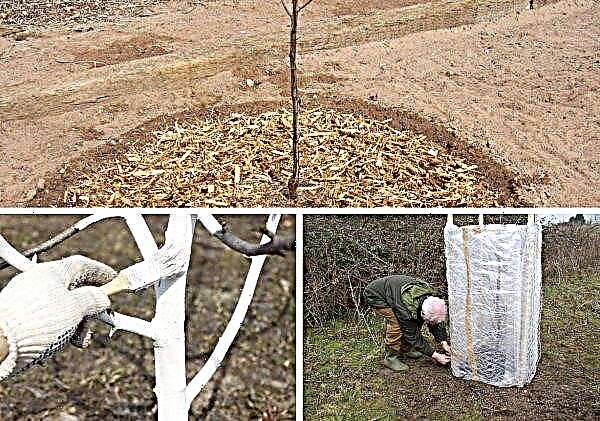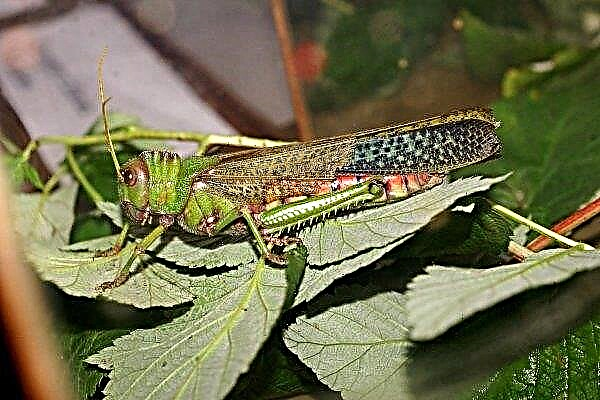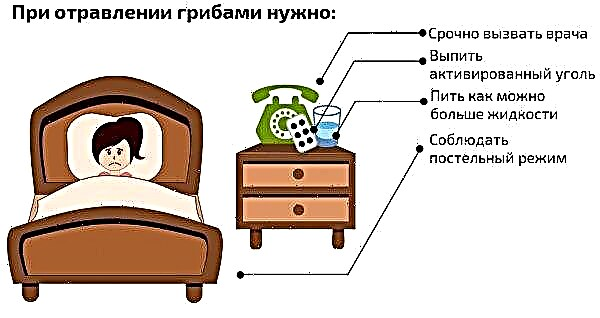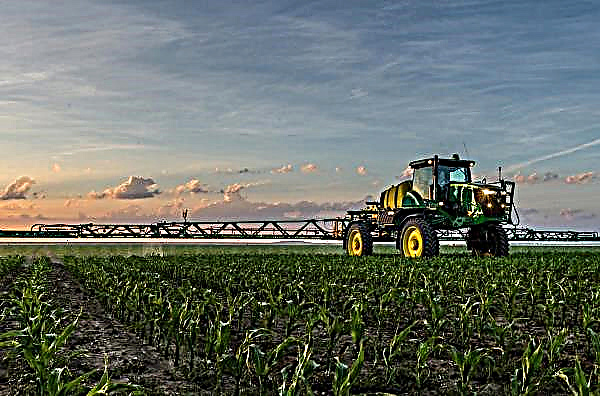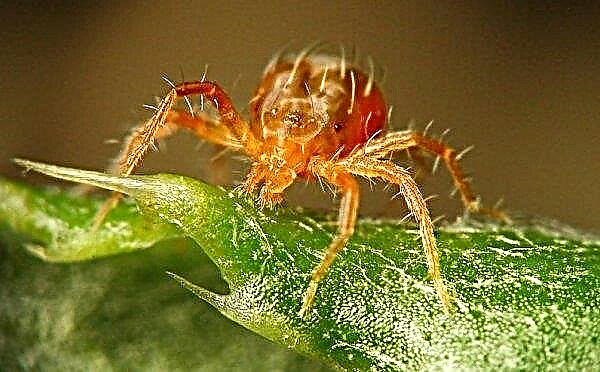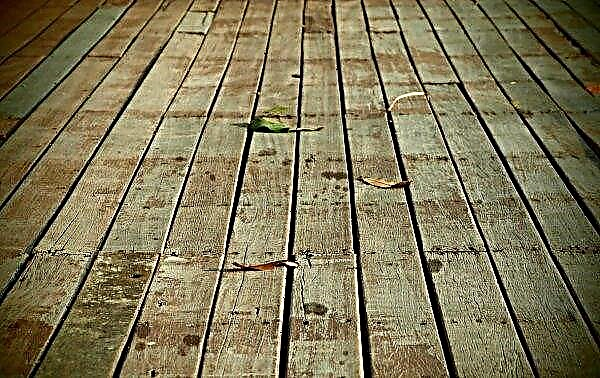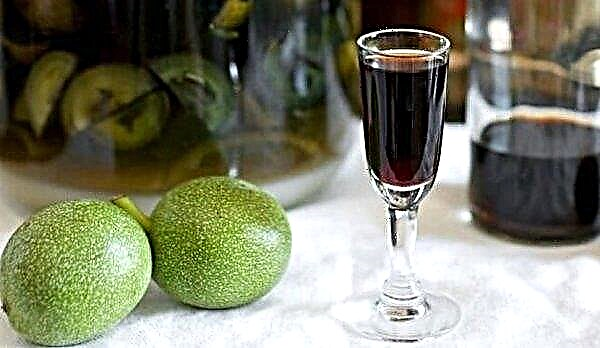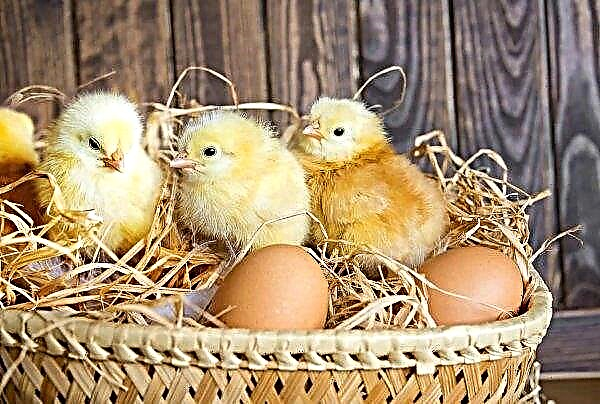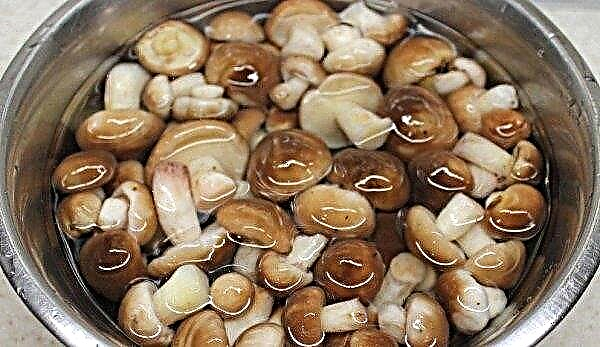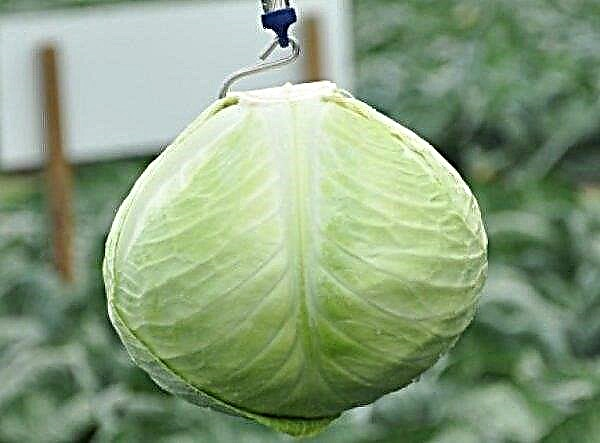The term “pepper-shaped tomatoes” implies several varieties that have a common feature - the outward similarity of ripe tomatoes with sweet pepper fruits. The remaining signs - the colors of the fruits and their sizes, plant height, etc., may vary. We will talk about pepper-shaped varieties of tomatoes and their cultivation in the article.
Description of pepper-shaped tomato varieties
A hybrid called "Pepper-shaped tomato" was obtained on the basis of the popular tomato variety "Cream". The authorship belongs to the agricultural company "NK. LTD." Hybrid registration took place in 2001. The resulting product has an elongated and oblong shape resembling pepper. Many later followers of the hybrid in question have improved characteristics compared to it.
Did you know? The closest relatives of tomatoes are potatoes and tobacco.
Giant
The “pepper-shaped giant” was created by Siberian specialists in 2005, and two years later, the Demeter-Siberia agricultural firm patented its work. The variety got its name due to the fact that its fruits were really large, but only in comparison with the original variety. Characteristics of the "Pepper-like giant":
Characteristics of the "Pepper-like giant":
- the average weight of this tomato variety is 200 g; individual specimens can reach a weight of 250-300 g;
- length up to 15 cm;
- in a fully ripe tomato, the color is scarlet, saturated, uniform, the surface is smooth;
- the taste is concentrated, fragrant, sweet, fleshy flesh and quite dense;
- the fruit has 3-4 chambers with a not very large number of seeds;
- the crop can be harvested as early as 100-120 days after the seedlings begin to emerge;
- a large bush can grow up to 1.5–2 m tall;
- from 1 m² it is possible to collect up to 6 kg of crop;
- universal application of the product.
Orange
At about the same time as Giant, Agros breeders bred a variety called Pepper Orange, which grows well in mid-climate and achieves record results when grown in greenhouse conditions. Characteristics of Pepper Orange:
Characteristics of Pepper Orange:
- the fetus weighs an average of 135-170 g, can reach 300 g;
- the color to which the variety owes its name is saturated, bright;
- the skin is dense, the pulp is juicy, fleshy and tender, while quite thick;
- about 85–90 days elapse from the first seedlings before harvesting; the variety bears fruit for a long time and abundantly;
- the bush can reach 150-180 cm in length;
- the variety is shade tolerant, has increased resistance to a number of diseases characteristic of the culture;
- from 1 m² you can collect 7–9 kg of crop;
- universal application of the product.
Important! Seedling "Pepper-shaped orange" stands out among other varieties in that it can tolerate an insufficient amount of light without harming itself.
Striped
The variety has an original color in the form of blurry yellow stripes and stains on an orange fruit. Characteristics of "Cerium Striped":
Characteristics of "Cerium Striped":
- the fruits are large enough - their average weight is 100-120 g;
- color orange with yellow stains;
- the palatability is excellent, the pulp is dense, as is the skin that does not crack during heat treatment during canning;
- the bush is stunted, can grow up to 80 cm, in rare cases (in greenhouse conditions) reaches a meter long;
- in general, the variety is resistant to disease, with the exception of apical rot;
- begins to bear fruit 110–115 days after sprouting;
- from 1 m² you can collect up to 7 kg of crop;
- ideal for canning, tasty fresh.
Did you know? The word "tomato" has Aztec roots. In the original language it was called "tomato", the French changed to "tomate", from there the name passed into Russian.
Yellow
Variety of tomato "Pepper yellow" bred in 2005. It has a low acidity and is approved for use by those who are not recommended for health reasons. Characteristics of "Pepper yellow":
Characteristics of "Pepper yellow":
- fruit mass can reach 150 g;
- the skin color is orange, the flesh has a bright yellow hue;
- the pulp is medium-dense, aromatic, has excellent taste;
- fruiting occurs 116–120 days after emergence;
- the length of the bush reaches 180 cm, needs pinching;
- the variety is resistant to heat and drought;
- increased resistance to many culture-specific diseases;
- fruiting for a long time, productivity from one bush reaches 3.5 kg;
- universal application of the product.
Pink (Raspberry)
The variety “Pepper pink” (or raspberry) was obtained relatively recently: Novosibirsk breeders bred it in 2015. Characteristics of the variety in question:
Characteristics of the variety in question:
- the fetus reaches a mass of 125–250 g;
- fully ripened, it acquires a rich raspberry color;
- fruiting occurs 100 days after emergence;
- excellent taste, sugar, fleshy flesh;
- the variety is determinant, the bush does not need pinching - being compact enough, it does not grow above one and a half meters;
- when grown in a greenhouse, it can produce 12–15 kg of crop per 1 m².
Did you know? Cultivated tomato fruits can weigh up to 500 grams, and some up to a kilogram — despite the fact that its wild relatives bear small berries weighing 1 gram.
Fortress
The variety “Pepper-shaped fortress” was developed in 2014 by Siberian specialists in order to adapt it to severe weather conditions. Characteristics of the described variety:
Characteristics of the described variety:
- the fetus has a mass of up to 150 g;
- the color is raspberry, the stalk may remain green, which does not affect the taste;
- excellent taste, sweet flesh;
- begins to bear fruit after 105-110 days;
- the height of the bush does not exceed 40 cm, it does not need to be formed - the variety is determinant and standard;
- increased immunity to diseases;
- adapted to severe climatic conditions, grows well in open ground;
- not very high productivity (4 kg per 1 m²) is compensated by the taste, unpretentiousness of the variety and its adaptability even to harsh West Siberian conditions.
Cuban black
This variety can also be called "Cuban pepper", "Pepper black" or "Brown Cuban". Variety characteristics:
Variety characteristics:
- the shape of the fruit is original, not too elongated and slightly corrugated, its weight varies from 200 to 350 g, but can reach 400 g or more;
- the color of the tomato is rather brown than black;
- taste is very high;
- has fleshy, fleshy pulp almost without seeds, but not everyone likes its dense skin;
- in the greenhouse, bushes grow about 2-3 meters, in the open ground they are rarely more than a meter long;
- yield with good greenhouse care can reach 10-12 kg from one bush.
Did you know? In German, a tomato is called a paradise apple, in French — the apple of love, the Swedes call the wolf peach.
Red
In 2015, the “Pepper Red" variety was developed, bred by Aelita breeders. In general, it is almost identical to “Pepper-shaped orange” with a difference only in bright red color and some superiority in yield with proper care.
How to grow seedlings on your own
Gardeners do not collect seeds of pepper-like varieties on their own, since they are hybrid. When purchasing seeds in a store to grow seedlings, keep in mind that they do not need soaking and additional processing.
Optimal timing
When calculating the time of sowing seeds in the soil, you must consider:
- the estimated date of planting seedlings in the ground (this is done when the danger of frost is blowing, the period varies from region to region) or a greenhouse;
- the period required for its cultivation, which, depending on the particular variety, varies from 45 to 65 days.
Soil mix
It is better to buy ready-mixed soil, you can also prepare it yourself. A suitable mixture can be made from:
A suitable mixture can be made from:
- two parts of peat;
- one part of the land from a garden or vegetable garden;
- one part of compost;
- half of a piece of clean sand.
Before use, it is advisable to disinfect the prepared mixture by soaking in a solution of potassium permanganate or calcining in the oven. After this, the substrate must be well moistened.
Important! Disinfection should be carried out a few days before sowing, so that beneficial microorganisms have the opportunity to settle and multiply in the prepared soil.
Capacity for growing
Seedlings of pepper-shaped tomatoes can be grown both in the total capacity (box, tray, etc.), as well as in individual ones. In the first case, you will need to pick safely germinated sprouts into individual containers with a volume of at least 200 ml after the first true leaves appear. Many prefer to use the option with individual germination, so as not to disturb during the dive the delicate root system of the plant.
Many prefer to use the option with individual germination, so as not to disturb during the dive the delicate root system of the plant.
Garden shops offer:
- peat cups;
- peat tablets;
- special cassettes and the like.
Sowing seeds
When sowing seeds in a common box or tray, the following parameters must be observed:
- depth of grooves - 1.5–2 cm;
- distance between seeds - 2 cm;
- the distance between the grooves is 3-4 cm.
After the seeds are sown, they need to be sprinkled with soil, water and cover with a film to create the necessary greenhouse effect.Important! The thicker the planting, the sooner it will be necessary to dive the sprouted seedlings from seedling containers.

Seedling Care
When the seedlings begin to germinate (this happens after about a week or a little less), the containers with it, covered with a film, are exposed on the lightest and warmest window sill. For fast and successful germination, it will take about 25-30 ° C during the day and at least 20 ° C at night.
In such a “mini-greenhouse” it is necessary to maintain humidity of at least 80–90% - the surface of the earth has always been moistened. If it dries, it is necessary to additionally moisten the plant from the spray gun. The opposite situation is also possible, when mold, dangerous for plants, appears from excess moisture on the ground. In such cases, additional ventilation of the seedlings is required so that excess moisture can freely evaporate.
There should be enough light, otherwise the seedlings will become thinner and stretch upward. The required light time is 12-15 hours. If the sun cannot provide it, it is necessary to illuminate the sprouts with special lamps. The first fertilizing with complex fertilizers is carried out in 10-14 days, when the first true leaves appear.
The first fertilizing with complex fertilizers is carried out in 10-14 days, when the first true leaves appear.
Subsequently, you need to feed the seedlings every 2-3 weeks, depending on its condition and needs.
Important! Do not forget to insulate the surface of the window sill, on which there are containers with seedlings, polystyrene foam or other insulating material, which will protect them both from possible overcooling from window glass and from overheating from the battery.
For top dressing, you can use purchased ready-made complex fertilizers or make them yourself. To do this, on a 10-liter bucket of water you need to take:
- superphosphate in solution (35 g);
- potassium sulfate solution (12 g);
- urea (4 g).
Video: Topping tomato seedlings
Seedling hardening
It is recommended to transplant already hardened seedlings into the soil: this is necessary so that the plants adapt faster and better to a new place. To do this, two weeks before the alleged disembarkation, containers with seedlings are regularly taken out onto the veranda or, if there is no severe cold, to the street for 1-2 hours. If this cannot be done due to extreme cold, airing is required. In this case, you need to ensure that there are no drafts.
At the same time, the night temperature drops to 12-14 ° C. Three days before planting in the soil, the ambient temperature is gradually brought to the temperature that plants will have to face after transplantation, however, avoiding sudden changes.
Planting seedlings in a permanent place
Planted seedlings are planted at about two months of age, namely when there are 6 true leaves on the plant. Planting is carried out when the danger of night frost has already passed - in different regions these terms can be different: southern gardeners traditionally do this in early May, residents of more moderate climatic regions - in June.
Important! Among pepper varieties there are cold-resistant, developed specifically for harsh climates — they must be planted in accordance with the recommendations for a particular variety.
Low-growing varieties are planted in a well-fertilized and moistened soil according to the 40 × 40 cm pattern. When preparing a place for tall varieties, you should also take care of props and / or trellises, their planting pattern is 50 × 70 cm.
How to care in the open ground
Tomatoes, and in particular, pepper-shaped, are not too whimsical - even beginners can grow them. Caring for them boils down to a few simple but important points:
- water regularly;
- fertilize plants;
- to pinch and tie if necessary;
- care for the soil.
Watering
Regardless of the variety, tomatoes require regular watering. For undersized varieties, there is a need for watering:
- immediately after the plants are transplanted into the ground;
- 3 weeks after planting;
- after the tomatoes have bloomed;
- at the end of June.
 "Rain" watering is not advisable when water falls on the aboveground part of the bush. It is best to make a groove next to the garden bed and pour water into it.
"Rain" watering is not advisable when water falls on the aboveground part of the bush. It is best to make a groove next to the garden bed and pour water into it.Important! It is recommended to water early in the morning or in the evening when the sun leaves the sky. This reduces the evaporation of moisture from the soil and eliminates the risk of sunburn when water enters the plant.
Fertilizer application
Fertilize tomatoes three times a season:
- complex fertilizer during transplanting;
- manure or chicken droppings a month after planting, when lateral roots develop;
- ash when the plant blooms.
 It is necessary to monitor the condition of the plant bushes: if they look dry, then nitrogen fertilizers are required, if the mass is gaining too quickly, phosphate top dressing is used.
It is necessary to monitor the condition of the plant bushes: if they look dry, then nitrogen fertilizers are required, if the mass is gaining too quickly, phosphate top dressing is used.
Stitching and tying bushes
It is not necessary to pinch all varieties of pepper-shaped tomatoes: low-growing ones are limited in growth on their own. The same varieties to which such a technique is applied, through pinching, are formed into one or two stems, which allows:
- compactly arrange the plant in the garden;
- provide him with comfortable conditions (get the right amount of air, sunlight, etc.);
- make the most of the bush for optimal productivity.
Removing stepchildren, taking away moisture and nutrients, is done until they grow more than 5 cm. If you remove them at a later age, the plant will get stress, and the remaining wound will be dangerous for it. It is better to carry out the procedure in sunny weather, then the wound, drying out, will heal faster.
Soil care
Beds of tomatoes must be regularly released from weeds, which take useful substances and nutrition from cultivated plants. This procedure can be combined with loosening the soil, which will give additional oxygen access to the roots. The first time you need to loosen the soil to a depth of 10 cm, in subsequent times it is enough to cultivate 4-5 cm from the surface.
Many gardeners use mulching, due to which the soil does not dry out and less watering is required for tomatoes.Mulching also protects against weed growth, which eliminates the weeding procedure.
As mulch use:
- shredded weeds, preferably without seeds;
- compost;
- humus;
- special materials sold in specialized stores.
 Pepper-like varieties of tomatoes make a pleasant color and taste variety, and everyone, even a beginner gardener, can grow them. Tomatoes of different colors, sizes and shapes will be a great reward for the work done.
Pepper-like varieties of tomatoes make a pleasant color and taste variety, and everyone, even a beginner gardener, can grow them. Tomatoes of different colors, sizes and shapes will be a great reward for the work done.

